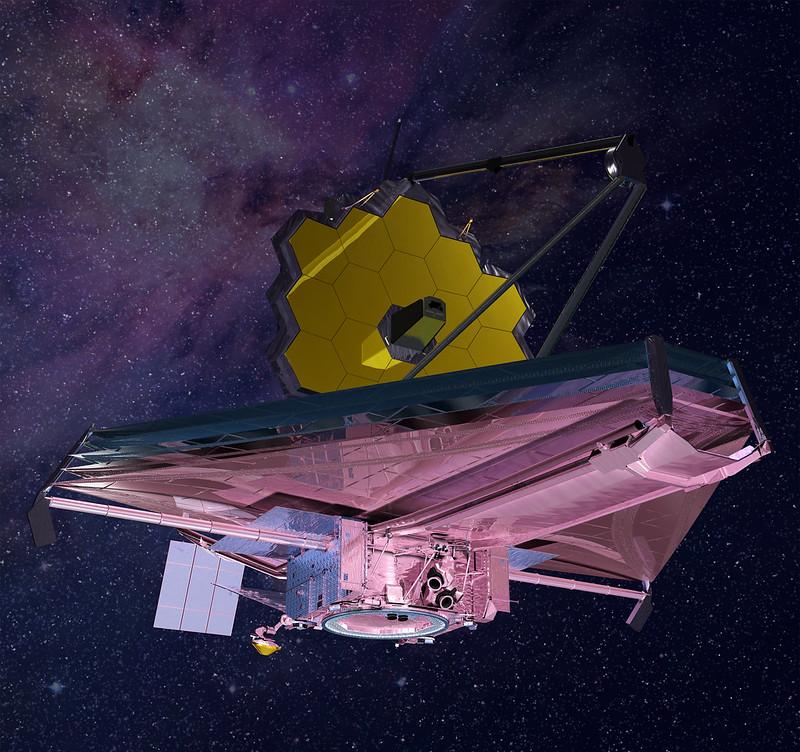The Surging News reporter Liu Hang
According to NASA news on October 12, the James Webb Space Telescope (JWST or Webb), the world's largest and most complex space science observatory at a cost of $10 billion, has successfully arrived in French Guiana in South America on October 12 after a 16-day, 9,300-kilometer sea voyage.
Now, it is being transported to the launch site, the European spaceport in Kourou. Once there, it will begin two months of preparations before scheduling a launch on the European Space Agency's Ariane 5 rocket on Dec. 18.

Webb Telescope
The universe is expanding, so the farther we look, the faster we see the celestial bodies moving away from us, causing the light to redshift. Redshift means that light emitted as ultraviolet or visible light is increasingly moving toward redder wavelengths, into the near- and mid-infrared parts of the electromagnetic spectrum. Therefore, studying the formation of the earliest stars and galaxies in the universe necessitated observing infrared light and using telescopes and instruments optimized for this light.
Named after James Weber, the second NASA administrator who led the Apollo program, the Webb telescope is a large infrared telescope with a main mirror of about 6.5 meters.
As a successor to Hubble, Webb's scientific goals are driven by Hubble's results, and the two function differently. Weber observes the universe primarily under infrared light, while Hubble studies the universe primarily at optical and ultraviolet wavelengths (although it has some infrared observation capabilities). Weber's main mirror is also much larger than Hubble's (2.4 meters in diameter), and the larger light collection area means that Weber can go back in time longer than Hubble. Hubble's orbit is close to Earth (about 570 km above Earth), while Weber will be at the second Lagrange point (L2) 1.5 million km away.
Once operational, the Webb telescope will become the premier observatory for the next decade, serving thousands of astronomers around the world. It will study every stage in our cosmic history: back in time to the beginning of the Big Bang, and will help find signs of potential life habitability among the thousands of exoplanets discovered in recent years. The mission was led by NASA and carried out in cooperation with the European and Canadian space agencies.
"The Webb telescope is a tremendous achievement designed to change the way we think about the universe and provide amazing science," said NASA Administrator Bill Nelson, "and Weber will look back at the light that was produced after the Big Bang 13 billion years ago, and it has the ability to show humanity the most distant space we have ever seen." ”
After completing tests in August at the Northrop Grumman Space Park in Redondo Beach, California, the team spent nearly a month folding, storing and preparing the device for shipment to South America.
The Weber telescope is transported in a custom-made, environmentally controllable container. The container is called STTARS, which is an acronym for air, road and maritime space telescope transport vehicles. Weighing about 76,000 kg, 5.5 meters high, 4.6 meters wide and 33.5 meters long, STTARS is equipped to prevent any unexpected situations that the telescope may encounter on the road.
STTARS is essentially a mobile cleanroom. While the telescope is in transit, STTARS keeps the contaminants inside the container low — no more than 100 airborne particles larger than 0.5 microns in size. (0.5 microns is one percent the diameter of a human hair.) )
Late on the night of September 24, the Webb Telescope was escorted by police to Seal Beach at the Naval Weapons Station. There, it was loaded into the spongy cargo hold of the French-flagged cargo ship, the MN Colibri, which protects cargo from weather and ocean, and is equipped with other equipment and launch-ready supplies. The MN Colibri left Seal Beach on Sunday, September 26 and entered the Panama Canal on Tuesday, October 5 for Kourou.
The sea trip represents the final stop on Weber's long journey to Earth for many years.
In 2013, the Webb telescope began assembling at NASA's Goddard Space Flight Center. In 2017, it was shipped to the Johnson Space Center for cryogenic testing at the historic "Room A" test facility. In 2018, it was shipped to a space park in California to begin rigorous three-year testing to ensure it was ready to operate in a space environment.
"This highly complex observatory was built by a talented team spanning the United States, Canada and Europe." Thomas Zurbuchen, deputy director of NASA's Science Mission Board in Washington, D.C., said.
The Webb telescope will separate from the Ariane 5 launch vehicle half an hour after launch, after which the solar array will be deployed automatically. 12 hours after launch, the small rocket engine mounted on the Webb telescope itself will perform the first trajectory correction maneuver; the second trajectory correction will be performed 2.5 days after launch. Lift off for about a month, and then make corrections to ensure that it will reach its final orbit. After that, instrument adjustments are made in a planned manner.
Six months after launch, the Weber telescope will begin its scientific mission and conduct routine scientific operations.
Editor-in-Charge: Li Yuequn